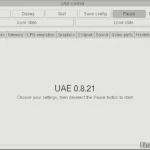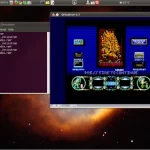Last Updated on: 9th January 2024, 12:32 pm
Web site: oric.free.fr/emulator.html
Category: Machine Emulators
Platform: Linux, Mac, Windows, DOS
License: Proprietary
Interface: GUI
Wikipedia:
First release: January 29, 1995
Euphoric – an emulator of the Oric operating system. Available for MS-DOS, Windows, Linux, Macintosh and Cassiopeia platforms. The project is no longer being developed.
Euphoric-1 changes (build 1000) (the last one):
– VGa Mode X (320×240 unchained) is back. More and more people use LCD screens, and mode Q (256×256 chained) is not always supported by these screens. Also, on some low-entry cathodic screens, mode Q is only supported with scanlines (i.e. each of the 256 lines is displayed twice). Thus, by default, the configuration file (euphoric.ini) comes with option VGAMode=X. It’s up to you to replace this option with VGAMode=Q if your monitor allows it (this option will allow you to adjust your monitor settings to get rectangular pixels, like on the Oric), and then you might want to try option ScanLines=No if you wish to get more natural pixels (round pixels), with a small gap between lines.
Using Mode X has some implications : Windows does not show Euphoric in a “freeze” window when you switch to another application (Alt-Tab), because of the non-linear memory configuration of this mode. Thus, you will have to use Euphoric’s screen hardcopy instead of Windows snapshot feature (it’s now easier with the F12 key).
– Removed the display of jpeg cassette inlays at startup. Sorry, guys, I was wrong to have people scan cassette inlays in such a low resolution. It would be much better to have a front-end Windows program, that displays good-looking cassette inlays and then launches Euphoric…
– Some options that were previously usable from the command line are now in the configuration file. There’s nearly no command-line option left, except those that allow to select different Orics (they are used the bundled Windows shortcuts). Don’t forget to read through the default configuration file to learn the available features, it’s now much better self-documented.
– the environment screen (accessed with F1) has been simplified and some functions are easier to access, like the screen snapshot feature using F12 instead of PrtSc; some people find it difficult to prevent Windows from trapping PrtSc.
– tape searching is slightly different: if you start Euphoric by double-clicking a tape image, the location of this tape is used first when looking for other tapes: the standard tapes directory (the one specified in euphoric.ini) is only used if a tape is not found. Also, there were a few bugs in the handling of tapes and roms directory names (when a drive letter was specified), this is now fixed.
– dumping of PSG registers has been changed: the value of register #13 is now saved as $FF if it has not been rewritten between two interrupts (this helps YM players). Registers are dumped every VIA’s timer 1 interrupt. This does not guarantee a faithful sampling of music because some programs do not play music through interrupts (e.g. Doggy). When you use a YM player, don’t forget Oric’s PSG frequency is 1 MHz (like on the Amstrad CPC) and the “usual” interrupt frequency (hence the sampling frequency) is 100 Hz, not 50 Hz as found on computers that use Vertical Blank interrupts. Moreover, some programs select an unusual interrupt frequency: for example, Damsel has a 83 Hz interrupt frequency…
– ASCII keyboard mode has been removed: it used an ugly trap inserted in the keyboard entry rom routine. If you don’t have a US keyboard, please use the “nationalized” roms : these roms include support for a national keyboard, like if such a keyboard was plugged on a real Oric (this is not a fiction: I also use one of these roms on a real Oric with a true AZERTY keyboard, this keyboard having been rewired for the Oric use).





